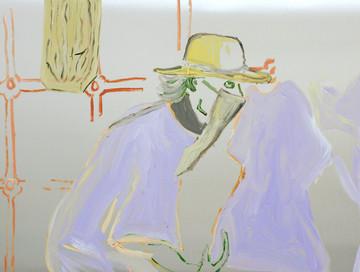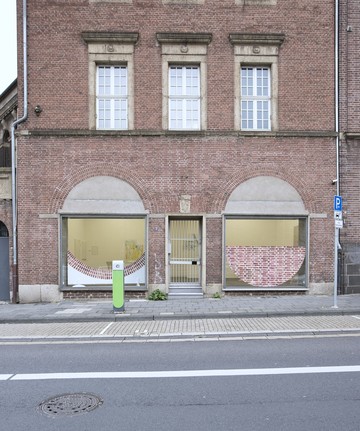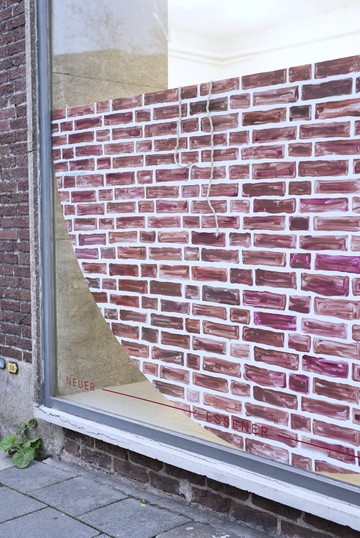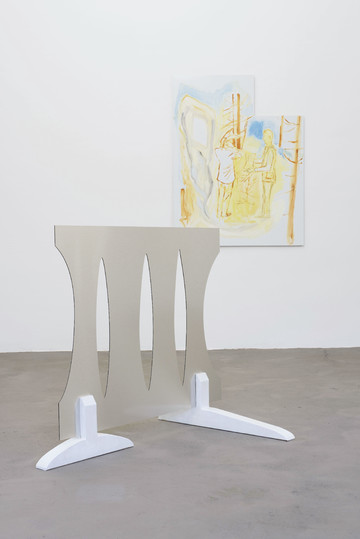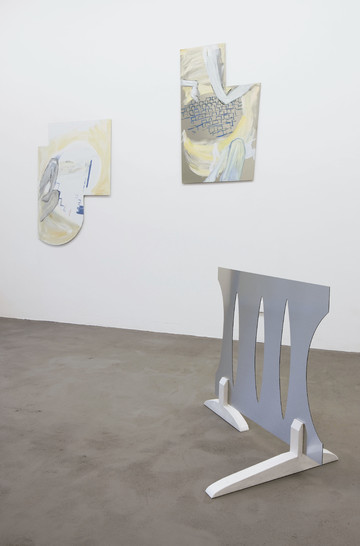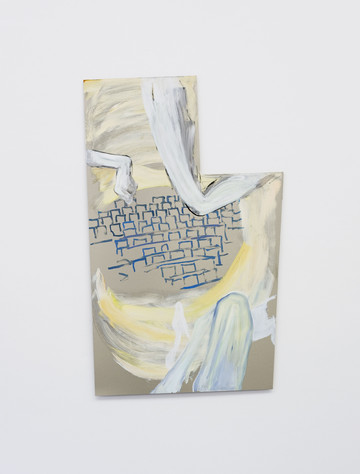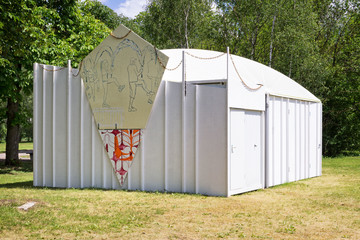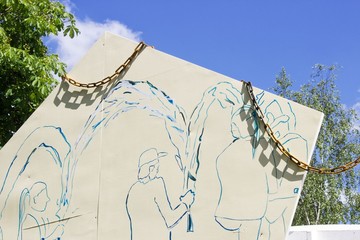Maximiliane Baumgartner’s (b. 1986) painting practice is both geared towards and cohabitates within a practice of community-oriented play and activity, which she terms as an ‘actionist pedagogy’; one situated in a liberated field, autonomous from the conventional contemporary educational system.
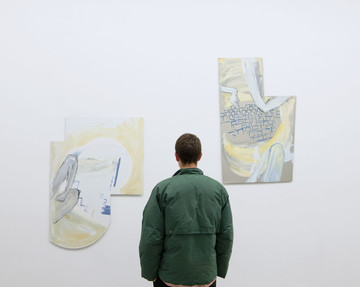
Baumgartner’s paintings transcend from the traditional form: they are rarely executed on canvas or linen, and they are rarely quadrilateral. Platonic forms are resisted and rejected, in favor of polygonal figures and indecipherable, morphic forms, with no inherent sense of top, bottom or side. Some utilize transparent surfaces, synthesizing the illustrative subject painted upon the transparent material as co-existing with the background, and thus creating an optical ‘third space’. Other paintings fold around architectural spaces, molding themselves into corners of the room, or even extending past the material frame of the wall, rigidly hovering out into the space, occupying the room, claiming sovereignty from the confines of their traditional exhibition structures. These containers for painting enact postures (or even, attitudes) that suggest a departure from painting itself. Each painting is a character in this “make believe” play.
The unorthodoxy of the form and frame emulate the peripheral. This, when posed in relation to human vision, mimics the elusive shape of the periphery of the visual field, which is literally the information absorbed by the visual organs (eyeball, retina, etc) and processed by the human brain in the areas outside of the so called ‘point of fixation’. Precisely, Baumgartner is not interested in the points of fixation, or in other words centrality: instead, her strategy is to deflect the notion of focus or locality altogether. There is a sense of fluidity, or an urge to keep all things moving, in a constant state of flux. The paintings are notational and gestural. They are not accumulative, and they are certainly not illusionary. This is further enhanced by the many paintings completed upon a brushed, industrial aluminum, which creates a mirror-like surface. The viewer thus projects themselves into the artwork, while simultaneously being reflected back. The incorporation of the viewer’s own body, coupled with the strangely peripheral effects of the shapes of the painting surface, create a sort of panoramic field, one into which the subject of a painting is not bound by it’s frame, but becomes a component in a larger collection of paintings, themselves in turn extended from the private into the public sphere.
There is an attitude of “roaming” or “wandering” inherent to the work, which points to the influence of the enchanting figure of Gusto Gräser, whom Baumgartner often cites as a significant source of study and inspiration. Gräser was a wandering poet, dancer, “natural prophet”, pacifist, and painter whose life was symbolically and figuratively always in motion: in other words, a transient. In different forms, her practice is an attempt to emulate his pedagogic form of Herumstreifen (or roaming), which she feels contrasts with the lived experiences of people today, especially children and teenagers. In this sense we could pose the deliberate reallocation of her practice in the 19th century as an anti-technological, anti-algorithmic stance rather than simply esthetic nostalgia.
–Amanda Schmitt
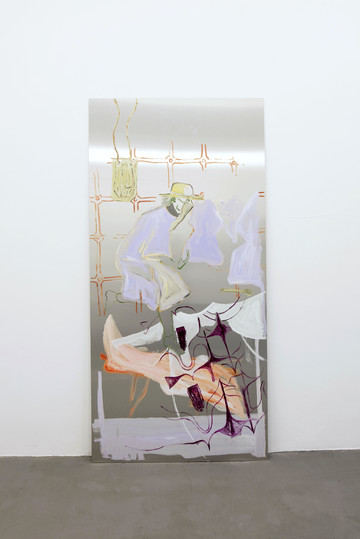
The title of Maximiliane Baumgartner’s exhibition at the Neuer Essener Kunstverein, Ich singe nicht für Bilder schöne Lieder [I don’t sing beautiful songs for pictures], already deals with the mediation of painting. In it, the representative façade of the Kunstverein migrates into a series of paintings created with reference to Jean Genet’s play The Balcony. Genet’s play reads as a parable of an all-encompassing longing for representing and the preservation of power, but also of the deceptive aspect of images and their supposed meanings.
In the paintings, the balcony motif is used as a multi-layered metaphorical parable for contemporary political conditions. Depending on the context, it may symbolize a transitional space, the threshold between the private and the public, but also the exposed position of representing. At the same time, the balcony, and with it every picture of him, forms a scenographic element for Baumgartner that spans a space for the mediation of her own work.
Due to this, Baumgartner’s work splices two fields, which usually remain separated, although they actually depend on each other: On the one hand the artistic proposition, and on the other, its aesthetic and content-related mediation. Educational reformers can be found in it, as can reformist play settings or references to architecture and public space. Moreover, Baumgartner breaks up
the isolation of individual images through the special formats of her images, which seek points of contact with the spaces of their presentation through their exceptional cuttings. Accordingly, individual paintings become scenic elements that open up a space leading to the images, a space that could perhaps be described as a space of mediation. Concretely, this step from surface into space is acted out with the façade front of the Kunstverein here, which Baumgartner deliberately plays into the space.
The spectrum of distancing and involvement also takes place at the level of content. Three of the paintings refer to the post-democratic emptying of political representation. The German parliament, recognizable by its blue seats, is shown with various painterly means at the greatest possible distance from its visitor’s balcony. In addition, Genet’s drama, which is more of a notion for this exhibition, also deals with the power of images, which is also extremely present in the exhibition. Just think of the image of empty seats in parliament, which the German right-wing party AfD (in repetition of the Nazi-party NSDAP) wants to produce. Or of the parliament in general as an image of representative democracy.
This technocratic apparatus, which comes to nothing in the face of new-right structures, endangers parliamentary democracy from the inside, is compared in the exhibition with the German fable of the donkey who learns to read. This early satire of an ossified technocracy tells of an examination board that can be convinced of the reading skills of a donkey just because it can say Iih-Aah - representatives who satisfy themselves in their function.
Baumgartner contrasts such a representative with the hidden self-portrait Wanderpoetinnen I [Wandering Poetess I], which shows the artist in the role of the poet, dancer and life reformer Gusto Gräser, who is performing his bumblebee dance. The picture goes back to a dance that Baumgartner (dressed as Gräser) performed with children and adolescents in the action space and art educational project Der Fahrende Raum. On the one hand, she activates this now somewhat forgotten “figure of the alternative movement” and co-founder of the artist colony Monte Verità, emphasizing a visible break with a rather male-dominated tradition. And on the other, in connection with the exhibited distance to parliament, the picture appeals to get involved.
–Moritz Scheper
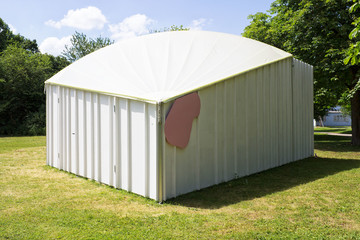
The reception is a dance, the Hummeltanz. The group buzzes around, their faces partly covered or with colourful make-up, dressed in oversized white shirts. The word ‘bumblebee’ is repeated over and over again, the dynamics of what is spoken change constantly, becoming louder, faster, quieter, slower, synchronised and dissonant. The bodies try to join in, sometimes it runs smoothly, then it stutters, tilts into the pathetic will, tilts into a silly need to move on, becomes serious and concentrated again.
In Maximiliane Baumgartner’s painting ‘Trigger Copy Hummel’ the same dance is depicted, portraying Gusto Gräser reading under a tree, to the left. Born in 1879, the inventor of the dance acted as artist, poet, bohemian, travelling vagabond, pacifist as well as co-founder of the artist internal commune Monte Verità in the Swiss Alps. Partially penetrated by the dancing figures, he is observed by a small dog at the lower edge of the picture, of which only the back of the head can be seen, third person perspective, currently known from role, adventure and action games.
The opening dance and the painting are a few hundred kilometres apart, staggered by a few days - here open air in Munich-Freimann, there in the rooms of Galerie Kirchgasse in Steckborn, Switzerland. On a meadow in Munich-Freimann, the pavilion of the ‘Fahrender Raum’ stands in the summer of 2018, a self-reported “art project and action space for art mediation and artistic action in the urban context in Freimann, Munich. For children, adolescents and adults”. Sounds like the title of a chapter in a multi-page project proposal to a respective foundation and remains all the more puzzling in the intention of publishing something formulated in this way if one compares it with the practice.
The pavilion, designed and built by Baumgartner together with Jochen Weber, is twice the size of an allotment garden house, a little higher, the entire front can be opened and becomes a stage space and houses the constantly growing ‘Performative Gusto Gräser Children’s Archive’. Next door are scenery buildings, a walk-in row of houses, and a little off the beaten track Jonas Beutlhauser’s chicken house with chickens romping around, pecking, sometimes being chased around.
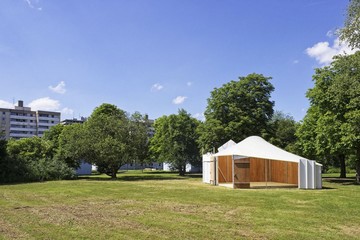
Baumgartner writes in an accompanying publication that “the city of Munich has a history of artistic spaces for action” and states that these were attempts at self-organization in public space, especially in the late 60s and 70s of the 20th century. The transitions to the happening and action art scene emerging in Munich at the same time are fluid, a prominent example would be Aktionsraum 1, founded in 1969, and there are other exciting names to mention: the KEKS group, abbreviation for ‘Kunsterziehung Kybernetik Soziologie’ (art education cybernetics sociology), and Pädagogische Aktion (PA), both groups of activists, artists and social pedagogues who joined forces to occupy the Munich Art Academy in 1968 and subsequently developed spaces for action and play with the direct involvement of children and young people on the streets, in parks, empty factory buildings and inns, ruined villas or in the German pavilion at the Venice Biennale. The ‘Kunstpädagogische Dienst’ (KPD) as a division of Kultur & Spielraum e.V. continues to work in this tradition of pedagogical-artistic play spaces with projects such as the ‘Spielstadt Mini-München’ to this day.
2015, Freimann, an empty supermarket, on a handcrafted poster in the shop window says: “100 % discount. When you go in, you get 100 € for free!” - a plain lie, the supermarket has closed shop here. It is rather a promise: The simultaneous stage of ‘Fahrender Raum’ celebrates its opening here. “Everyone may enter the common place as a potential producer, which has been permanently reinterpreted as a catwalk, parade ground, filming location, documentary and stage and functions as a launch pad; as a space of opportunity for invented and real actors and versions who manage to claim this row of shops for themselves,” says artist Mirja Reuter, summarizing the jointly experienced and constructed in the ex-supermarket.
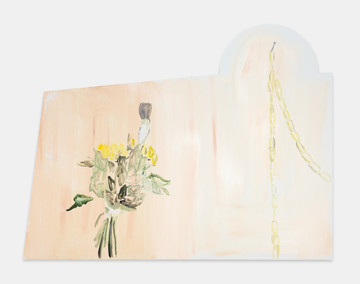
2018, again in Steckborn, Gallery Kirchgasse. The already mentioned painting ‘Trigger Copy Hummel’ is part of a series of eight paintings on Alu-Dibond painted with lacquer. The impression of the documentary is created by the fact that figures are usually recognizable in the foreground, acting in front of a scene-like middle ground and in front of a radically empty, maximally primed background. The desire to show again what has already happened, wants to be recorded, must also be quickly captured: Model-like constructions that refer to the architectural playground intervention ‘The Red City’ in Munich’s Olympic Village; motifs borrowed from the parallel events of the ‘VagabundInnentreffs’ in the pavilion, again and again Gusto Gräser, who until 1958 spent the last 16 years of his life in Freimann, often accommodated here with friends and sitting on trees, distributing his poetry en passant in the form of self-designed printed works and pamphlets.
At the same time, the unusual formats of the pictorial come to the fore - little representative panel painting, no landscape-format panorama aspirations, no simple rectangles, but cut-away nested surfaces and sections. The contours are reminiscent of forms of windows, doors, wall surfaces that have been removed from a more comprehensive architecture and now here on the wall, as they hang there, also have something comical about them: Fragments of a stage set, on which past performances are inscribed and now once again set in scene.
Self-reflection of the medium of painting? Definitely, but in the series as a whole also an installation whose elements do not know where to go; with individual pictures acting as fitting pieces that find no counterpart. Baumgartner’s decision not to want to produce what is supposedly suitable, be it painting for an exhibition, be it a pedagogical action, consequently delivers results that can never be identified as purely positive, as “pure” art or as “pure” (art) pedagogy, but always also indicate their missing part, pointing to the blind spots of the respective fields of art and pedagogy. Baumgartner’s practice consistently problematizes the current contemporary method of differentiating the fields as clearly as possible, then putting them into relation again and redirecting the interdisciplinary theoretical profit gained into an “artistic” or “pedagogical” application. After all, this method tends to reinforce a production/reception habitus that may be linguistically precise and differentiated, but is also disciplinarily professionalized and willing to accept only one’s own language, often following idealistic, normative goals corresponding to the respective field, and thus always implicitly hierarchizing in relation to the other field. Instead of responding to the analytical problem with promises or solutions, Baumgartner prefers to continue producing too much art AND too much pedagogy at the same time. Overtaxing as an anti-method that manages to drag the historical and present conditionality of claims to autonomy and heteronomy (of both art and pedagogy) into the light, thus always exhibiting them.
For clarification, the image of the simultaneous stage might help here once again, on which different actions are to be regarded as parallel not because they take place simultaneously, but because they occupy a comparable position in the overall performance. So the question of what is the work of art and what is the pedagogical action is simply the wrong question because the answer will never fit.
Following the primacy of direct action, Baumgartner is not concerned with clever answers to questions from the audience that are never stupid, of course, but with the direct effect of these actions on the participants. The effect of the events, of the pictures, of the performances and lectures, of the catwalk, of the 100 % discount, of the fantasized stories in the pavilion is a produc- tive uncertainty of the beautifully practiced role-plays - finely adjusted yesterday evening at the opening class or loosely performed this morning while hanging out at school - here things don’t go smoothly any more. Not for children, not for teenagers and not for adults. It never fits properly and therefore remains a nice problem.

Lacquer on aluminium dibond
246 x 119 cm
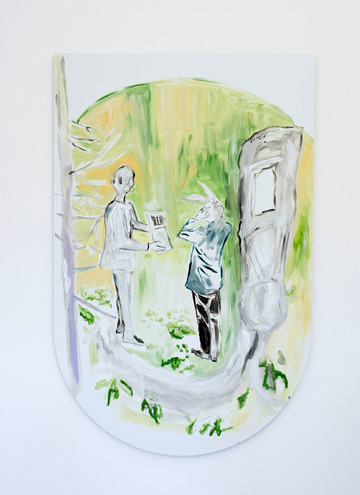
Lacquer on aluminum Dibond
140 x 90 cm
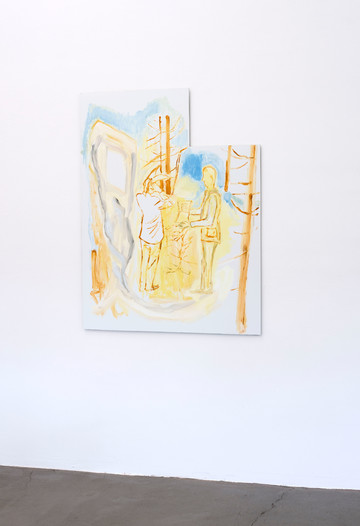
Lacquer on aluminum dibond
130 x 100 cm
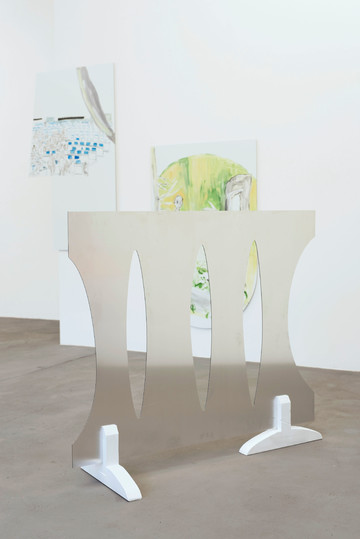
Lacquer and aluminum dibond on wood
100 x 125 cm

